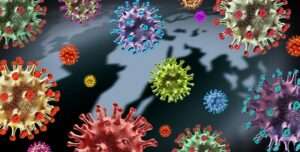New COVID Variant: Government Issues Advisory When JN.1 Subvariant Is Detected
This week, mass information began to circulate about a case of COVID-19 detected in India and Mexico that attracted

This week, mass information began to circulate about a case of COVID-19 detected in India and Mexico that attracted attention: it is the variant known as Pirola or JN.1, a subvariant of Omicron.
The first case of the Pirola variant of COVID-19 was confirmed in CDMX; these are the symptoms.

Although not precarious, it is effortless to transmit, revealed by the National Autonomous University doctor and researcher.
Although it caused a lot of commotion
Although the ‘confirmation’ of this first case caused a lot of commotion, it was reported that it was highly contagious. The reality is that it is a case that was detected on November 24 and that the World Health Organization itself (WHO) does not consider that it is a variant for which activities should stop, like three years ago when the Covid-19 pandemic began.
“The real importance it has is that it may be the one that dominates infections in the December-January season, so it is recommended to be a little more alert. “To take reasonable care of yourself,” the UNAM epidemiologist said in his X account.
What are the symptoms?
The WHO classified this variant as a follow-up since cases worldwide are believed to increase during winter. In addition, natural immunity or that provided by the first vaccines applied may not be effective. Its main symptoms are:
- Hoarseness or roughness
- Congestion
- Headache, muscle or throat pain
- sneezing
- Fever
- Loss of smell
- Cough
If people detect these symptoms, they must avoid spreading them, so doctors recommend using face masks and avoiding meetings. Likewise, they explained that the sectors of the population that should be taken more care of are those less than two years of age, adults, and people with comorbidities.
If it is highly contagious, why is it not dangerous?
This variant and one called Eris had already had cases in other parts of the world for just over three months. In this regard, Dr. Alejandro Macias, renowned infectious disease specialist and ‘Influenza Czar’ during Felipe Calderon’s government, explained in a video that Pirola does not have much transmissibility. Still, it does have a lot of escape – since it must find a way to disperse – and that is why it can infect more people.
How dangerous is the Pirola variant of COVID-19 that arrived in CDMX
“It seems that Pirola is the ‘reborn’ of a variant that had already disappeared; the implication is that if it begins to spread, although there are very few now, it could eventually re-infect a good part of the population when they already have immunity, but be careful “There is no need to be alarmed, it is not more serious than usual,” the doctor pointed out.
In another video, the infectious disease specialist explained that it is very likely that there will be a rebound between December and February cases of respiratory diseases, including Covid-19, but not because it is a new wave but because the virus is already seasonal. It is circulating in the environment along with those that cause influenza and even respiratory syncytial (RSV), of which several positives have been detected in recent weeks.
Experts explain what the behavior of the virus will be during the season.
“The evolution of the virus favors its transmission, the virus wants to infect us again but it does not favor mortality. It is false that everything is pointing out that things are going to get worse,” stated the so-called ‘influenza czar.”







